|
Diving to Extremes
An animal physiologist goes to the bottom of the earth to study Weddell seals, the southernmost mammals. Gwyneth Dickey plunges in. Illustrated by Kristin Link and Liza McElroy.
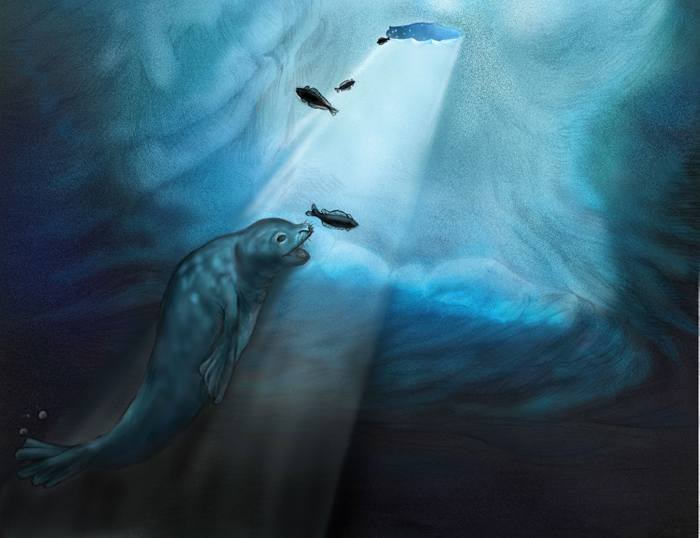
Illustration: Kristin Link
The researchers rushed across the ice to their cabin, popped in the flash card, and sat down to watch. They had just retrieved the winter's first equipment package and couldn’t wait to see the new footage. They leaned forward and suddenly plunged into the sea off Antarctica, diving deeper into a world no human had ever explored. They rocketed through the dark water, veering left and right, up and down, for more than 20 minutes.
They were riding on the back of an 800-pound Weddell seal.
The seal took them on a vicarious journey to the depths of McMurdo Sound, 850 miles from the South Pole. He carried a package of instruments that would give the researchers new insights into the behaviors, body adaptations, and striking hunting tactics of the sleek animals. With powerful jaws that gnash through the ice to make breathing holes, Weddell seals are the only mammals capable of surviving the extreme cold, ice and storms of the Antarctic winter. Their specially adapted lungs and thick layer of blubber allow them to dive nearly a mile deep—sometimes for 90 minutes at a time.
“Those capabilities are so phenomenal for a mammal that they're fascinating in their own right,” says animal physiologist Terrie Williams of the University of California, Santa Cruz, who co-led a team of researchers to the Antarctic in August 2009. “Now we're trying to look at one more extreme, which is total darkness.”
After 25 years of research on this animal, Williams is addressing her next big question: How do the seals find fish in the dark Antarctic winter? Along the way she is discovering more about their unique physiology, social interaction and battles with climate change. In the end, she wants to make sure they thrive in the face of natural and human challenges.
“There are lots of Weddell seals out there," says Williams, "but that could turn around tomorrow.”
The bigger the better
Williams has devoted her career to studying large mammals. Her fascination began in grade school with a series of articles and photo spreads in Life about big cats, clippings she still has in her attic. In college she took up an interest in swimming and began to wonder why some mammals were better divers than humans. Now she studies both land and marine mammals, working out how they make a living and how humans should allocate resources to preserve them.
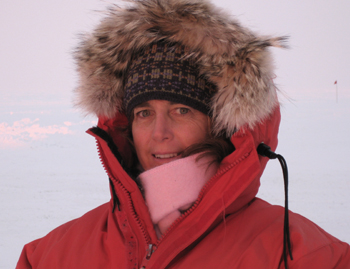
Photo: Randy Davis
UC Santa Cruz marine biologist Terrie Williams in Antarctica, August 2009. |
|
|
Williams has a lean build and deeply tanned skin from all her time outdoors. Her bright blue eyes light up when she talks about the animals she studies. At her lab in Santa Cruz, she works with a variety of marine mammals, including two Atlantic bottlenose dolphins, Primo and Puka, whom she’s studied for sixteen years.
Williams first started studying Antarctic Weddell seals as a postdoctoral researcher in 1983. Since then she’s traveled to the South Pole eight times, asking and answering new questions about how this animal is adapted to such harsh living conditions.
On their 2001 expedition, Williams and her colleagues became the first to strap cameras on Weddell seals. Puzzling footage from their dives showed that the seals actively swim only down to about 70 meters. Then, they glide for the rest of their descent. Williams knew seal lungs collapse during dives, compressing the air inside to a smaller volume. This makes the seals heavier than water. She realized the seals must be taking advantage of this alteration, swimming only deep enough for the air to compress, and then they just sink. The process works in reverse to help bring them to the surface.
By conserving energy in diving, the seals can hunt and stay underwater for up to 90 minutes, Williams deduced. She later saw the same gliding behaviors in diving dolphins and blue whales.
On that same expedition, she found that seals rely on backlighting to hunt in the brightly lit summer. The cameras, which used near-infrared light invisible to the seal, gave an “over-the-nose” view of the seals’ behavior. They revealed that the animals swim down deep and look back up toward the surface ice, brightly lit by the sun. They see the silhouettes of their prey against the bright ice, and then swim up to capture them.
Now she wants to know how the seals find food in the dark Antarctic winter. Can they still rely on vision without sunlight? Footage from the team's latest expedition showed that the seals use any light they can, even moonlight, to go hunting. “Anyone who’s been on the Antarctic ice during a full moon knows that it’s like a spotlight,” says Williams. “Any kind of light will penetrate the ice.” She thinks that in winter, the seals cram their hunting into the brightest part of the day. More video analysis will reveal what the seals do with no sun or moon.
It’s hard to study the seals in total darkness. From February to early August, the darkest months, there are no flights into or out of Antarctica because of hazardous weather. People either stay all winter or come in early August, the tail end of the total winter darkness. Since Williams can’t spare six months to “winter over,” she goes down as early in August as possible. But even if she gets there while it’s still dark, the animals are hard to find out on the ice. They live round-the-clock in the water at 27°F. “It’s like a spa for the animals,” Williams says. “The water is 97 degrees warmer than the air.” Next year, the team hopes to get an even earlier August flight so they get as much dark time as possible.
One striking new finding, Williams says, is the ferocity of seal fights below the ice. Seals selfishly guard scarce breathing holes in the tightly packed winter ice. After a long dive below the ice, one seal often has to chase off another to breathe. It swims at top speeds, jaws agape, biting and clashing with its opponent. Videos show sometimes bloody underwater battles that leave seals scarred and bruised. Williams says that after watching the seals perform these vigorous feats, she’ll have to adjust her models for how the seals save oxygen during a dive.
Finally, Williams expects to determine how the seals exercise while their bodies are in dive mode. When a diving animal submerges, it undergoes a natural dive response—its heart rate decreases and blood is shunted away from muscles to the heart and lungs. This conserves oxygen so the animal can function even though it’s not breathing. “The books will tell you things go into slow motion when animals dive,” says Williams. “But what about when the seals are swimming at these remarkably high speeds?” This year the camera packs had heart-rate monitors, so Williams will now determine how the dive response is modified when seals exercise underwater.
A seal’s-eye view
Compared to other large animals, Weddell seals are easy to work with. They have few natural predators above or below the ice, and with no built-in fear, they don’t mind humans. “They’re massive animals, but they carry a very gentle demeanor, where everything is kind of slow moving,” says Beau Richter, head animal trainer in the Williams Lab. But Richter says he uses caution with all wild animals. “The sharp end of any animal is always the one you fear. The tail end can do its own damage—that’s a lot of weight swinging around—but I always have my eyes on the sharp end.”
When the seals haul out on the ice to bask in the sun, the researchers easily transport them to their research hut. The seals require little sedation because Richter reads their moods and monitors their behaviors to keep them calm. “You can tell a lot by watching their eyes,” he says. “When they’re relaxed, their eyes are relaxed, and when they’re scared, their eyes are wide open.” Most of the time, he says, the seals are just plain curious.
The seals poke around and explore the lab while the researchers make sure they’re healthy enough to carry the gear. The team first takes quick body measurements. On average, the seals are 9 feet long, weigh 800 pounds, and have two inches of blubber below their gray fur to insulate against the cold. Next, the scientists put small facemasks on the seals to measure how much oxygen and carbon dioxide they exhale. Finally, a rubber cement-like glue attaches a neoprene patch to the seals’ fur, on top of which go the instruments. The instruments are easy to remove when the animals return a few weeks later, and the glue soon molts off with the fur.
The camera package was conceived by one of Williams’s co-investigators, marine biologist Randall Davis of Texas A&M University. What started as a plastic-encased Sony camcorder in 1986 is now a compact, state-of-the-art dive recorder. A webcam-sized camera sits on the seal’s head, connected by a cable to a canister full of tiny instruments on its back. The canister, about the size of an aluminum water bottle, contains a depth detector, hydrophone, speed sensor, GPS, thermometer, accelerometer, magnetometer, and sensors for dissolved oxygen, salinity, and light level. All of this weighs about as much as a large orange.
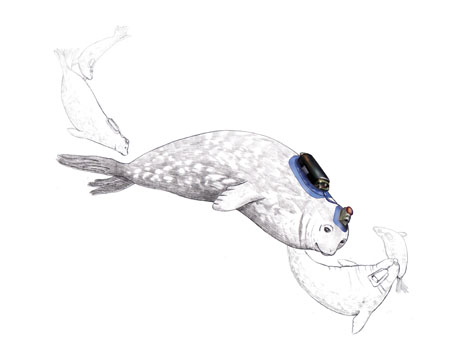 |
Illustration: Liza McElroy |
“When you combine video-recorded behavior with data from onboard sensors, we can recreate the three-dimensional dive path,” says Davis, who collaborated with an engineer to help realize his vision. “This opens up a completely new view on the lives of these animals at depth, which until these instruments was completely unknown.”
Once released, the seals stay underwater for weeks, diving, hunting and sleeping. The researchers can hear their calls under the ice from inside their research hut. The unearthly clicks, whoops, whistles, chucks, and booms filter through the floor, as if a downstairs neighbor were playing a loud space wars video game. Sometimes they’re so loud, Williams says, she feels the sounds through her boots.
While they wait, the team has time to appreciate the striking landscape. The thinner ozone layer above Antarctica makes for some fantastic rainbow-colored skies. But the rest of Antarctica is white, in all directions. “There’s an element of sensory deprivation,” says Williams, noting the lack of color, smell and sound. She says the silence is punctuated by the occasional burst of steamy breath as the seals come up for air.
The stark environment is stressful. The researchers wait anxiously for weeks for the animals to return with the equipment. If they don’t get the cameras back before the seals swim far out to sea, the data is lost forever. The team huddles inside the research hut to avoid frostbite from the -70°F wind chills. Since temperatures are below freezing all the time, their thyroids go into overdrive to keep them warm, which causes short-term memory loss. They need little green notebooks—what they call their “green brains”—to jot down everything from phone numbers to to-do lists.
All this can make the researchers go a little stir-crazy. “It’s more than cabin fever,” Williams says. “We’re dealing with harsh conditions, on top of the frustration of not moving forward, and it can be terrible for people trying to be cohesive and accomplish a goal.”
But when the seals return, the researchers are back in action. As soon as a seal emerges, satellite detectors beep back at camp. The team jumps on snowmobiles and drives out in search of the animal, guided by a radio antenna. It’s tricky, says Williams, but they almost always get the packs back.
This year, the team retrieved data from five seals, each with a unique behavior pattern. A young expedition member who brought J.K. Rowling’s popular Harry Potter book series gave each seal a character name to match its personality and appearance. The fighter of the group, “Hairy Potter,” boasted a scar on his face. “Hagrid the Seal” was the largest and most lethargic, but proved to be the strongest athlete, regularly diving for 40 minutes at a time. Ginger-muzzled “Ron WeaSealy” was the eater, and bore a slight resemblance to the red-haired boy in the books. “Neville Longbottom-Dive” was mild-mannered, while “Minerva MacGonaSeal” had a no-nonsense attitude.
Each seal gave the team different insights. The team learned to read Hairy Potter’s whiskers, which perked up at any sign of danger or nearby food. Minerva MacGonaSeal spent most of her time on the ocean floor, providing up-close camera views of the alien-like plants and animals there—teeming even in the Antarctic cold.
Dicey future
After 25 years visiting the Antarctic, Williams has seen the effects of climate change on the seals. While the ice is thinning overall, huge icebergs have started to crunch up against the seals’ living quarters in McMurdo Sound. The bergs choke off the surface layers of the ice that normally blow away, disrupting the seasonal cycle and allowing ice to accumulate and grow thicker.
The scientists have seen the ice thicken from 3 to 20 feet since the 1990s. This means seals can’t find breathing holes as easily on their under-ice journey to the nursing grounds. Natural cracks in which they can create and maintain holes are sparse in the tightly packed ice. Many seals, especially pregnant females, can’t swim far enough to get to the nurseries. They may get stuck under the ice and drown, or give up on the journey completely. One species, the Adele penguin, has already been pushed out of the area by the tight, thickening ice. The Weddell seal may be next, says Williams.
Species preservation is a big theme in her research. She studies the energy needs of big animals to find their “Achilles’ heel,” the possible downfall that may mean the end of the species. Seals, for instance, need to eat a certain number of fish every day. If humans take too many out of the ocean, seals have to scramble to find food. Williams studies other top predators like pumas, lions, elephants, elephant seals, whales and otters to find out their energy needs. Through her research, she can quantify the calories and resources that need to be put aside to support a given number of each species.
“One of the questions that always comes up in animal energetics is, what does it cost them to live where they live, and what happens if that changes?” says marine biologist Michael Castellini of the University of Alaska, Fairbanks. He says Williams “is one of the leading people on being able to ask that question by using many different animals.” She asks broad questions and comes up with innovative, often elegant ways of answering them, he says.
He is particularly impressed by her sixteen years of work on the two bottlenose dolphins, which she has trained to leap alongside speedboats and rest underwater, enabling her to make metabolic measurements. “That’s so incredibly hard to do,” says Castellini. “It took years of training to do that. No one else has tried to do that work, because of the effort and dedication involved.”
Williams is concerned that so many researchers are worn out by the labor, expense, and paperwork involved in this kind of research. “My fear is that we’ll finish here and no one else will follow,” says Williams. “I think that will be to the detriment of the animals.”
For now, Williams carries out her research at full speed, studying the physiology of dolphins, sea otters, pumas, and most recently, a Hawaiian monk seal. She is working to establish a new center at UC Santa Cruz, one that melds mammalian physiology with genomic studies, to understand the genetic mutations that allow animals like the Weddell seal to thrive in extreme environments. “We’re looking at animals that people have never looked at before,” says Williams. “In the process, I hope we’ll preserve them.”
The team will return to the ice again in August 2010, gathering more data on the winter challenges of the Weddell seal. “We haven’t quite thawed,” Williams says. “Crazy as it sounds, we’re going back.”
Story © 2010 by Gwyneth Dickey. For reproduction requests, contact the Science Communication Program office.
Top
Biographies
 Gwyneth Dickey Gwyneth Dickey
B.S. (neurobiology and physiology) University of Maryland at College Park
B.A. (music performance) University of Maryland at College Park
M.A. (kinesiology) University of Maryland at College Park
Internship: Science News, Washington, D.C.
"Gwyneth, you wright so well."
Despite the ironic misspelling, something went ‘click’ when I read the message from my neuroscience professor. In that instant, I realized I wanted to write about science, not do the research myself. I had spent years trying to combine my interests in music, brain science, and child development into a fulfilling career. But I was more interested in showing kids their world through music teaching than studying how music shaped their brains.
That simple e-mail opened my eyes. I no longer had to strain to explore the world through the microscope of science academia. I could peer through the binoculars and telescopes of science journalism and see so much more. Now I embark on a new career path, one that will lead me to the far reaches of our universe.
. . . . . . . . . . . . . . . . . . . . . . . . . . . . . . . . . . . . . . . . . . . . . . . . . . .
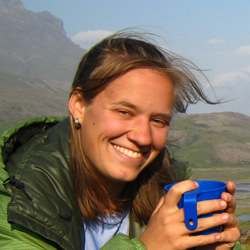 Kristin Link Kristin Link
B.A. (environmental studies: conservation biology, and studio art) Middlebury College
My mission as an artist is to create images that explain and excite people about their natural surroundings. If I am not drawing, then I am probably outside exploring and observing. I have always been curious about nature; I like to know why something looks the way it does and to learn how it works. I read field guides before I go to bed, and whenever I go for a walk I come back with some interesting thing I found in my pocket. In school my favorite subjects were art and science, and I was never able to give one up. Upon learning about the Science Illustration Program, I felt like I found my calling.
After graduating I am moving to the small rural town of McCarthy, Alaska, where I have two internships with the Wrangell-St. Elias National Park and the Wrangell Mountains Center. See my website at www.kristinillustration.com.
. . . . . . . . . . . . . . . . . . . . . . . . . . . . . . . . . . . . . . . . . . . . . . . . . . .
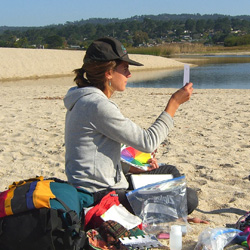 Liza McElroy Liza McElroy
B.A. (environmental science) Colorado College
Internships: American Precision Museum, VT and The Alaska Sea Life Center, AK
At a time when it seems the resources of the natural world are being stretched and ecosystems are going through many changes, it is more vital than ever that we understand the science of what is happening around us. For this reason, I am drawn to illustrating issues regarding climate change, the Arctic, the oceans, and how humans interact with and impact nature. I am equally inspired by illustrating and explaining manmade wonders: eggbeaters, bridges, solar panels, biodiesel, etc. With my illustrations I hope to inspire learning in all aspects of science and above all, encourage respect for the natural world.
Top |

